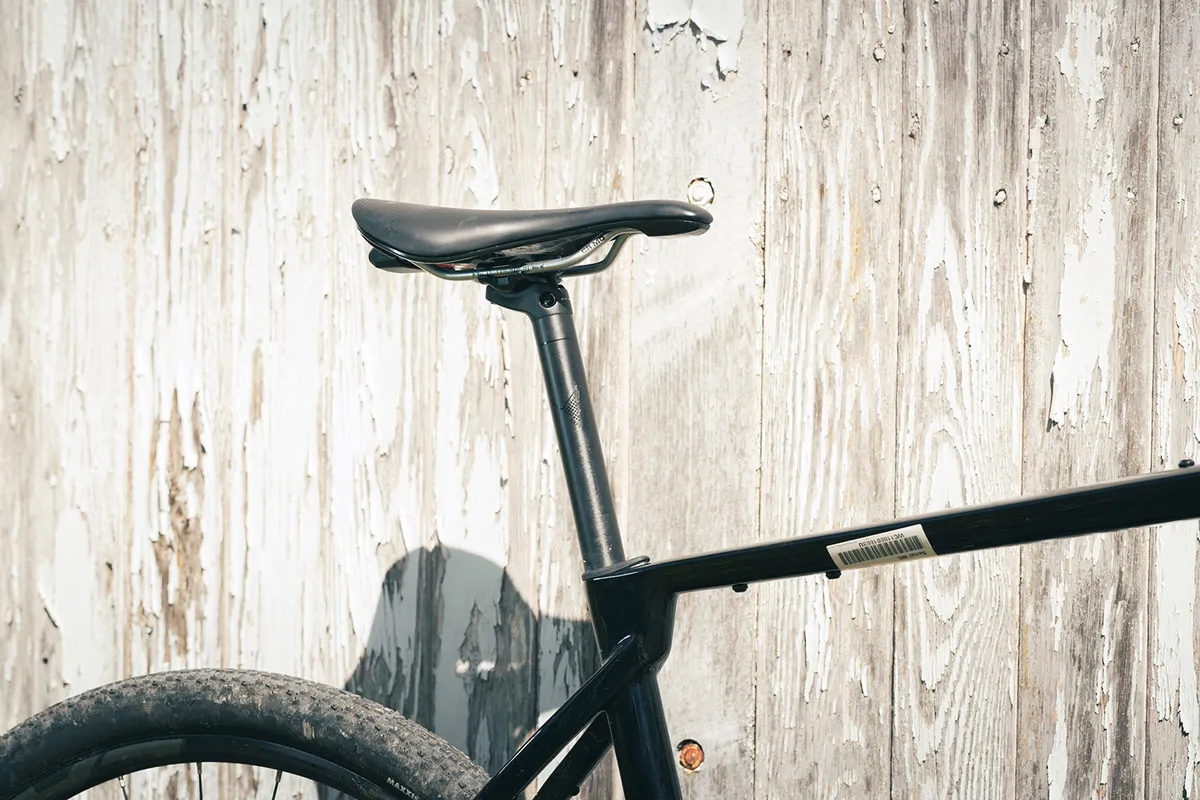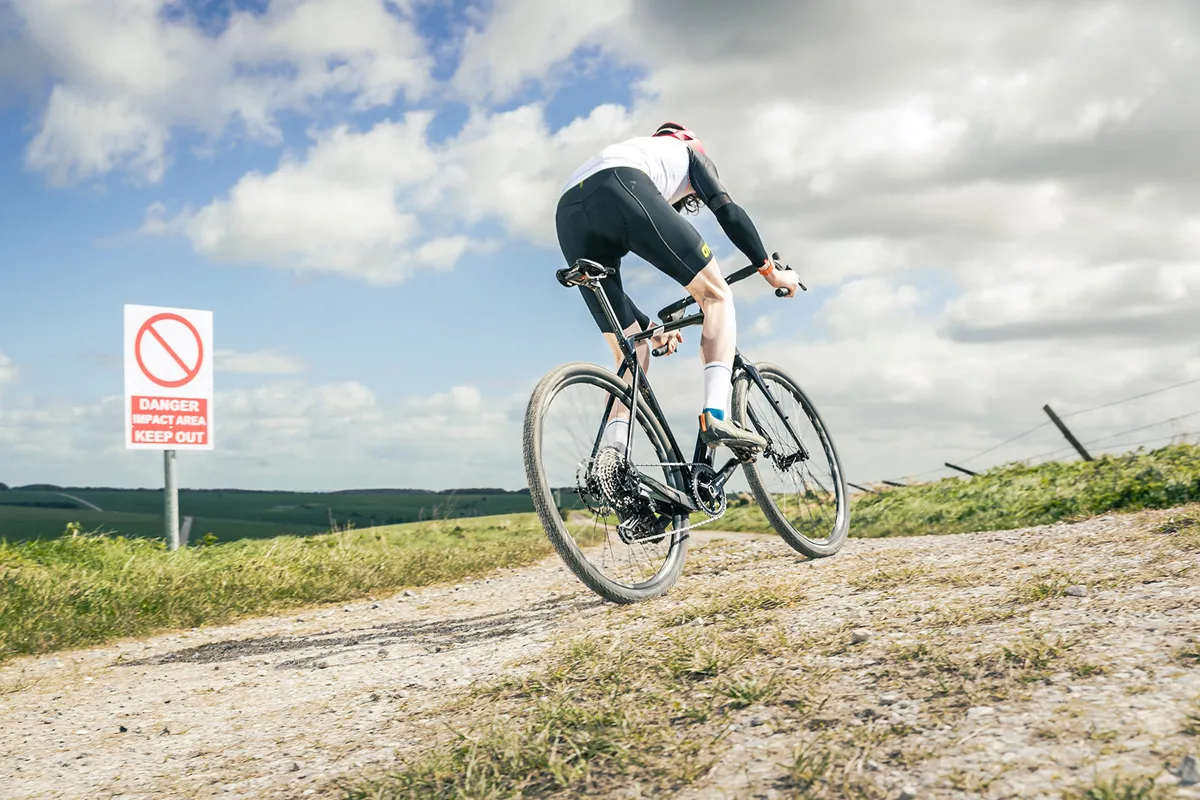The Merida Silex pairs a relaxed head angle and extended reach to deliver a gravel bike with better-balanced steering stability off-road than the steeper, shorter, classic drop-bar designs.
The bike is also no slouch on the road and hugely versatile, with many mounts for luggage and accessories.
It's a little heavy compared to the competition at 10.22kg for my size large test bike, but an excellent value-for-money build helps make up for that.
Merida Silex 7000 frameset details
The fork axle-to-crown length has increased from 415mm to 397mm. This makes the Silex compatible with gravel suspension forks and increases tyre clearance to 45mm.
The chainstays have been lengthened to 430mm, bringing bigger tyre clearance to match the front.
The bottom bracket shell and chainstays have also been redesigned. This now allows for a 46-tooth chainring.
The frame weighs a claimed 1,220g for a size large bike and the fork 540g.

The frameset now features full cable integration via the Wire Port system first seen on Merida’s Scultura and Reacto road bikes.
Brake hoses and cables now route through the headset and into the frameset.
The fork also features routing for a bikepacking-friendly dynamo hub on the opposite leg to the brake, opening up the possibility of self-powered lighting and peripheral charging.
It also has triple mounts on the legs for further luggage carrying capability.
Plenty more fittings throughout the Silex frameset max out the bike’s versatility.
At the back, there’s a removable bridge to enable the fitting of mudguards.
The frame has bento box mounts on the top and underside of the top tube.

A set of magnetic Fidlock bosses are fitted onto the top of the down tube. You can fit a Fidlock bottle or a range of accessories to these.
Merida Silex 7000 geometry

The Silex’s long 426mm reach on my large test bike is combined with an endurance bike like 626mm stack height.
The frame is paired with a short 80mm stem on all sizes.The head angle is relaxed at 69.5 degrees.
It all adds up to a bike that's assuredly stable on rough terrain, albeit one with a sporty ride position.
| | XS | S | M | L | XL |
|---|---|---|---|---|---|
| Seat tube angle (degrees) | 74.5 | 74.5 | 74.5 | 74.5 | 74.5 |
| Head tube angle (degrees) | 69.5 | 69.5 | 69.5 | 69.5 | 69.5 |
| Chainstay (mm) | 430 | 430 | 430 | 430 | 430 |
| Seat tube (mm) | 440 | 470 | 500 | 530 | 560 |
| Top tube (mm) | 550 | 565 | 580 | 600 | 620 |
| Head tube (mm) | 130 | 150 | 170 | 190 | 210 |
| Fork offset (mm) | 45 | 45 | 45 | 45 | 45 |
| Bottom bracket drop (mm) | 75 | 75 | 75 | 75 | 75 |
| Wheelbase (mm) | 1,048 | 1,065 | 1,082 | 1,104 | 1,126 |
| Standover (mm) | 744 | 771 | 798 | 825 | 852 |
| Stack (mm) | 570 | 588 | 607 | 626 | 645 |
| Reach (mm) | 392 | 402 | 412 | 426 | 441 |
Merida Silex 7000 specification

The Silex 7000's build is impressive for the price.
Shimano’s latest 12-speed mechanical 1x12 GRX820 groupset is at the heart of the build.

The gearing combines a 42-tooth chainring and a wide-ranging 10-51t cassette.
At the top end, the 42/10 combination gives a 118-inch gear, which is close to a traditional 50/12 combo – ample for road-going speeds.
At the other extreme, a 42/51t mix gives just 23 inches – a much lighter than 1:1 ratio, which will see you still spinning on the steepest climbs.

The GRX hydraulic brakes are combined with large 160mm rotors. These offer a balance between power and a progressive feel that is as good as it gets for drop bar bikes.
Combined with the crisp-shifting 1x drivetrain, it’s hard to find a better mechanical system for a gravel bike.
Easton provides its EA70AX wheelset. These 24mm wide (internal) tubeless-ready aluminium wheels use Easton’s own hubs laced using straight-pull, double-butted spokes in a traditional three-cross pattern.
This sensible no-nonsense approach builds a tough, stiff wheelset that weighs a middling 1,670g (claimed).
The wheels are fitted with Maxxis’ excellent Rambler Exo TR tyres in a clearance-maxing 45c size. These are set up tubeless as stock.
The subtly flared aluminium Expert GRII handlebar is fixed via a short 80mm stem.

A slick carbon seatpost is topped by a short and comfortable saddle. This features Merida’s clever integrated mini-tool on the underside.
Merida Silex 7000 ride impressions

The Silex balances off-road handling chops without compromising its long-distance multi-surface capabilities.
While being superb when riding the most testing technical terrain, a lot of extreme progressive geometry gravel bikes are compromised on the road.
The handling stability can also make them steady rather than responsive climbers. On the other hand, the more responsive they are downhill, the less fun they are when riding back up.
Climbing on the Silex, like most gravel bikes, is best experienced in the saddle. That said, unlike a lot of slack, long front-centred designs, it responds well when you stand and inject pace and power.
It responds quickly to hard efforts. Unlike bikes with overly slackened front ends, such as the Nukeproof Digger RS or Marin Gestalt X10, it doesn’t flop when you get out of the saddle and over the front end on a climb.
However, Merida has struck an excellent balance between handling and all-round useability with the Silex.
On tarmac or ungraded roads, the Silex is swift and smooth.

Get onto singletrack woodland trails and the Silex tracks beautifully.
The compliance from the frameset and the longer fork combines with handling that is stable and sharp.
Pushed hard into a choppy descent, the bike tracked true and straight but proves capable when fast reactions were required.
Add in the superb brakes and fast, reliable gear shifts, and the Silex 7000 feels as if it’s up at the very highest echelons of what’s available in cutting-edge gravel design right now.
On sharp road ramps, it’s a willing companion. Even the chunky Rambler tyres that cope admirably in slick muddy conditions are capable on tarmac and don’t rob too much of your effort.

The bike looks great and the addition of quirky details shows plenty of attention has been paid to the full end-user experience.
Ideally, the Silex would improve with a little less weight – at 10.22kg, it’s not light.
By comparison, the similarly equipped and priced GT Grade Carbon LE is a full kilo lighter.
That said, all its components are tough and highly competent.
Gravel Bike of the Year 2024 | How we tested
For each of the bikes, I undergo a shakedown ride of 20 miles / 32km that takes in towpaths, light gravel roads, singletrack and a technical woodland trail descent.
Once I’m happy with the setup, I take longer days out on each of the bikes – one of my favoured test loops is a 50-mile / 80km route that takes in tarmac, towpaths, trails, wooded and sheep track singletrack, plus military-style gravel and doubletrack forest roads.
This test route is designed to represent the widest variety of gravel riding possible, with each contender ridden until the most impressive bike for its main usage case remains standing.
For Bike of the Year 2024, I’ve notched up in excess of 800 miles / 1,280 km.
Our Gravel Bike of the Year contenders
- Orbea Terra M41E Team 1x
- GT Grade Carbon LE
- Canyon Grail CF SLX 8 Di2
- Santa Cruz Stigmata Force
- Merida Silex 7000
Thanks to…
Our sponsor MET helmets, for its help in making Bike of the Year 2024 happen.
Merida Silex 7000 bottom line
Gravel bike designs are becoming more and more specialist. Be they lightweight racers, big-tyre, multi-mounted pack horses aimed at self-supported continent crossings, or gravity-focused pseudo mountain bikes for thrill seekers.
The Merida Silex competently spans a wide range of riding conditions, with great on-road manners, excellent technical terrain handling and a smooth compliance to the frame and fork.
In short, the Silex 7000 is one of 2024’s finest gravel bikes, riding well beyond its relatively modest build and price.
Product
| Brand | merida |
| Price | 3600.00 EUR,3000.00 GBP |
| Weight | 10.2200, KILOGRAM (L) - |
Features
| Fork | Merida Silex II CF2 |
| br_chain | Shimano M7100 |
| br_frame | Silex CF2 II |
| Tyres | Maxxis Rambler TR EXO 45c |
| br_brakes | Shimano GRX820 with Shimano RT64 160mm rotors |
| br_cranks | Shimano GRX820, 42t chainring, 175mm |
| br_saddle | Merida Expert SL |
| br_wheels | Easton EA70 AX |
| br_headset | Merida 8158 |
| br_shifter | Shimano GRX820 |
| br_cassette | Shimano CS-M7100 10-51 12speed |
| br_seatpost | Merida Expert CC |
| br_bottomBracket | Shimano SM-BBR60 |
| br_availableSizes | XS, S, M, L, XL |
| br_rearDerailleur | Shimano GRX822 |
